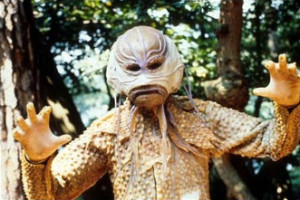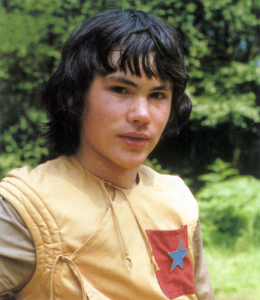 There are two things happening in this story: the story itself, and the launch of what will be a 3-part arc within season 18.
There are two things happening in this story: the story itself, and the launch of what will be a 3-part arc within season 18.
The Time Lords have demanded that Romana return to Gallifrey. She doesn’t want to go; she’s acquired the taste for travel and adventure during her time with the Doctor. But he knows from past experience it’s no use trying to evade the Time Lords. But something goes wrong: after a strange disturbance in flight, the TARDIS materializes on Gallifrey— or it thinks that it has. The scanner in the console room shows images of Gallifrey and the coordinates check out, but outside the door is a different world altogether, a planet called Alzarius. Gradually the Doctor and Romana realize what’s happened: the TARDIS passed through a freak space/time distortion called a “Charged Vacuum Emboitment” (CVE) and into the “Exo-space time continuum” (E-space for short). E-space is a peripheral universe (not a parallel universe) with negative space-time coordinates. Unfortunately the TARDIS’ systems only work with the absolute values, because the normal universe has only positive space-time coordinates. Our heroes may be trapped in E-space forever, since the TARDIS has no way to deliberately cross from negative back to positive coordinates.
Meanwhile, like everywhere the Doctor lands, the planet Alzarius has its own problems. Long, long ago a starliner from Terradon crashed on the planet. For generations the descendants of the passengers and crew have been working to repair the starliner, dreaming of the day (many generations still in the future) when the work will be completed and the great day of Embarkation will come and they will take off to return to Terradon. Every fifty years or so Alzarius experiences a climate shift called Mistfall, in which the atmosphere becomes cloudy. Believing the mist is toxic, the people retreat for ten years inside the starliner. But this is Dr Who, and the real danger isn’t the mist, it’s the fact that hostile monsters called Marshmen (which look like the Creature from the Black Lagoon) are wandering around in it.
There’s a band of teenage rebels who believe the local rulers, a triumvirate called the Deciders, are lying about everything just in order to maintain their own power. When the Doctor discovers the starliner is in perfect working order and could lift off at any time, he comes to the same conclusion— but the twist is that both he and the rebels are wrong. There’s a valid reason why the Deciders haven’t ever decided to lift off, and although they are far from perfect we learn they’re trying to do the best they can. But behind that, as the starliner comes under siege from the Marshmen, is an even more surprising twist…
Overall this is a good story. The E-space discussion is a bit more technical than we’re used to in Dr Who— that’s current script editor Christopher H. Bidmead’s desire to transform the series into hard SF at work. The main story also tries to be more scientifically grounded than Dr Who’s general level, with a great deal of it revolving around the Doctor working out the cell biology of the Marshmen and debating research ethics with a scientist willing to perform vivisection on a captured “Marsh child” in order to find out why they’re so aggressive. The dose of would-be hard SF doesn’t sit particularly well with Dr Who’s style, despite Bidmead’s efforts. Dr Who is not Star Trek. You can give the Doctor lines that sound like they came from a Larry Niven novel, but you’re still watching a story about swamp monsters attacking a village hiding inside a starliner while their leaders debate whether closing the bulkheads would be too hasty.
But on the other hand— you’re still watching swamp monsters attack a starliner, and that’s just good Dr Who. It could stand a little more effort to be scary— this story is one that would particularly benefit from the Hinchcliffe/Holmes “Gothic Horror” style— but that’s wishful thinking rather than a criticism. It hits the level that’s been Dr Who’s norm over the last few seasons, and does it well.
Details
- In the mid-seventies, Terrance Dicks and Malcolm Hulke published a little paperback book called The Making of the Doctor Who which talked about producing the series during the Pertwee era when Dicks was script editor. The book included the Writers Guide for the series that Dicks had devised (the first and only such “Series Bible” the Classic series ever had). (As an aside, the recent 50th anniversary special, Day of the Doctor, quoted from this guide— when the Doctors quote the “promise” in choosing the name Doctor, and say “never cruel nor cowardly, etc…” they are quoting Terrance Dicks’ instructions on how to write the Doctor’s character.) The published Writers Guide included discussion of the 4-episode story structure for Classic serials, advice on scene breakdowns for an episode, and other such material.
Reading it, in 1975 fan Andrew Smith wrote a Dr Who script and sent it in to script editor Robert Holmes. Though he didn’t accept it, Holmes was impressed enough to send it back to Smith with detailed and constructive comments and advice. Over the next few years, Smith continued to submit story treatments to Holmes’ successor Anthony Read, then to Douglas Adams— both of whom also sent him constructive advice— and finally to Christopher Bidmead, who liked Smith’s story treatment for Full Circle well enough to call him in for a meeting, discuss some revisions, and then commission him to actually write the script.
In 1980, when Andrew Smith’s Full Circle went into production, he was 17 years old— and the youngest writer ever to have a script produced for Dr Who. (Recently there was a contest for British schoolchildren to write a 3-minute “minisode” of Dr Who, and the winning entry was produced, but that wasn’t a regular episode of the series, nor was it accepted through an ordinary submission process, so Smith’s record stands.) - This episode introduces a new companion to the TARDIS crew, Adric.
 One of the teenage rebels on Alzarius, at the end of the story Adric stows away on board the TARDIS without the Doctor’s knowledge (the Doctor and Romana won’t discover his presence until the start of next week’s story).
One of the teenage rebels on Alzarius, at the end of the story Adric stows away on board the TARDIS without the Doctor’s knowledge (the Doctor and Romana won’t discover his presence until the start of next week’s story).
The character was devised by producer John Nathan-Turner separately from Full Circle and inserted into the story to introduce him to the series. JN-T envisioned him as a kind of “Artful Dodger” character, something which largely fails to come across— partly because actor Matthew Waterhouse was the wrong casting for that kind of character. Eventually the writers will figure out they need to write Adric differently to work with Waterhouse’ performance, but sadly Adric will never prove to be a particularly popular companion.
In fact, in the eyes of most fans he’s more or less Dr Who’s answer to Star Trek’s Wesley Crusher. The star on his tunic is a “badge for mathematical excellence” and as time goes on he’ll be presented as easily the Doctor’s intellectual equal, something which is tolerable in the Time Lady Romana but not in an annoying boy genius kind of character. - Meanwhile K-9 continues to be Dr Who’s answer to Mr Bill. He’s been frequently sidelined ever since he was introduced, even under producer Graham Williams who liked him, because of the difficulties of working with the K-9 prop. But JN-T and Christopher Bidmead seem to take a specific delight in bashing him to pieces. Two stories ago he trundled into the ocean, short-circuited, and exploded. Last week the Doctor was still repairing him and he was barely functional, and this week he gets a few minutes in the early part of the story before one of the Marshmen knocks his head off and spends the rest of the story carrying it around like a trophy. Poor old battered K-9 needs to leave the Doctor just for the sake of his own health…
- For the first time since the first season back in 1963-64, we get a glimpse of the living quarters on board the TARDIS. At the start of the episode, after the summons to Gallifrey, Romana is upset about having to go home and retreats to what is obviously her bedroom. Something else that JN-T was fond of, we’ll see the companions’ living quarters on board the TARDIS more and more often, at least for a while. Apart from the walls covered in the TARDIS’ distinctive “round things,” the decor looks mostly like a 1980s hotel.
Next Week:
“State of Decay,” 4 episodes.

